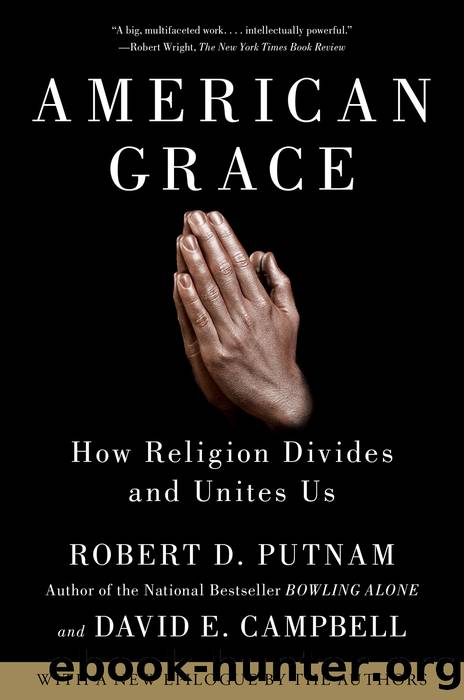American Grace by Robert D. Putnam

Author:Robert D. Putnam
Language: eng
Format: epub
Publisher: Simon & Schuster
CHAPTER 11
RELIGION IN AMERICAN POLITICS
Perhaps the most visible change in American religion over the last generation is the role it has come to play in the nation’s politics. Religiosity has partisan overtones now that it did not have in the past. While there are notable exceptions, the most highly religious Americans are likely to be Republicans; Democrats predominate among those who are least religious. Among the punditry, this connection between religiosity and the vote has been given the unfortunate but alliterative label of the God gap—the gap in question referring to the political differences between people at varying levels of religiosity.1 It is thus like the so-called gender gap, the difference in the partisan tendencies of men and women. And, like the gender gap, the coupling between religiosity and partisanship has become one of those unquestioned generalizations of American political life—an election day fault line endlessly discussed by political pundits and shrewdly exploited by political operatives.
This chapter and the next examine the connection between religiosity and politics, but from different perspectives. In this chapter, we deal with the political landscape. What has happened in the nation’s politics to drive a wedge between religious and nonreligious voters? And what might the political future hold? The next chapter then shifts the focus from what happens in politics to what happens in churches (and other places of worship). How do individual parishioners come to connect their religion with their politics?
We will first show that the glue which holds religiosity and partisanship together is the political salience of two issues in particular: abortion and same-sex marriage.2 Attitudes on both are tightly connected to religiosity—which is not a new development. The new part is that they have become politically salient, as the Democratic and Republican parties have taken opposing positions on both abortion and homosexual rights. As the parties have moved apart on these issues, religious and nonreligious voters have moved apart also. But, we suggest, should attitudes on these issues change, the religious divide in politics would likely also change. For while attitudes on same-sex marriage are moving sharply in a liberal direction, those on abortion are becoming somewhat more conservative—with both shifts most pronounced among young people.
Because of its longevity as a shaper of the partisan landscape, changes in abortion attitudes are especially portentous. Abortion has long been a wedge pulling more religious and less religious voters apart from one another. However, if unease with abortion becomes relatively common even among secular voters and comfort with gays relatively common even among religious voters, religiosity could cease to be a source of political division. If so, we could be headed toward a period of political “creative destruction,” an opening for political entrepreneurs to forge new coalitions.
Download
This site does not store any files on its server. We only index and link to content provided by other sites. Please contact the content providers to delete copyright contents if any and email us, we'll remove relevant links or contents immediately.
| Africa | Americas |
| Arctic & Antarctica | Asia |
| Australia & Oceania | Europe |
| Middle East | Russia |
| United States | World |
| Ancient Civilizations | Military |
| Historical Study & Educational Resources |
The Dawn of Everything by David Graeber & David Wengrow(1654)
The Bomber Mafia by Malcolm Gladwell(1583)
Facing the Mountain by Daniel James Brown(1504)
Submerged Prehistory by Benjamin Jonathan; & Clive Bonsall & Catriona Pickard & Anders Fischer(1420)
Wandering in Strange Lands by Morgan Jerkins(1374)
Tip Top by Bill James(1351)
Driving While Brown: Sheriff Joe Arpaio Versus the Latino Resistance by Terry Greene Sterling & Jude Joffe-Block(1339)
Evil Geniuses: The Unmaking of America: A Recent History by Kurt Andersen(1320)
Red Roulette : An Insider's Story of Wealth, Power, Corruption, and Vengeance in Today's China (9781982156176) by Shum Desmond(1315)
The Way of Fire and Ice: The Living Tradition of Norse Paganism by Ryan Smith(1305)
American Kompromat by Craig Unger(1271)
It Was All a Lie by Stuart Stevens;(1265)
F*cking History by The Captain(1254)
American Dreams by Unknown(1237)
Evil Geniuses by Kurt Andersen(1225)
Treasure Islands: Tax Havens and the Men who Stole the World by Nicholas Shaxson(1222)
White House Inc. by Dan Alexander(1179)
The First Conspiracy by Brad Meltzer & Josh Mensch(1140)
The Fifteen Biggest Lies about the Economy: And Everything Else the Right Doesn't Want You to Know about Taxes, Jobs, and Corporate America by Joshua Holland(1092)
